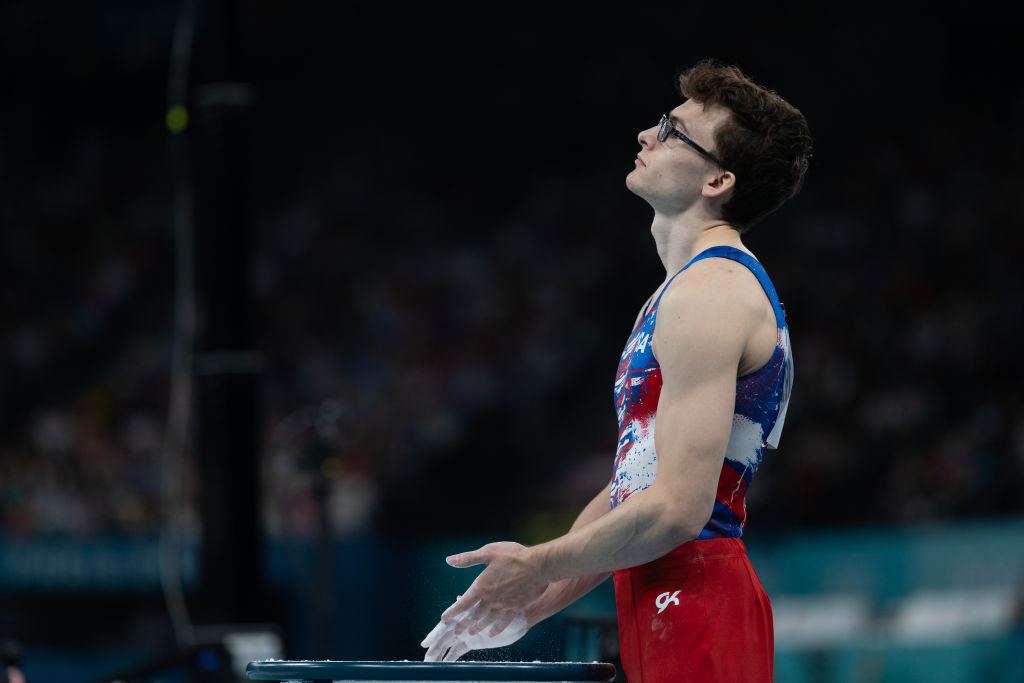---------------------------------------

Olympian Stephen Nedoroscik—a.k.a. “The Pommel Horse guy”—introduced Americans to more than just a niche sporting event when he helped the U.S. men’s gymnastics team clinch a bronze medal on July 29. He also raised awareness for an eye condition called strabismus, the apparent reason for the now-viral glasses he wears while waiting for his turn to compete, and which he hoisted in the air while celebrating with his team.
[time-brightcove not-tgx=”true”]
Dr. William Flanary, an ophthalmologist with EyeHealth Northwest in Oregon—best known for the satirical videos he posts as his comedic alter-ego, Dr. Glaucomflecken—posted on X that Nedoroscik’s fame is “possibly the greatest moment for glasses in Olympic history.”
“Just seeing someone like him on such a huge stage, winning an Olympic medal and unabashedly wearing his glasses…does a lot for making it normal,” Flanary tells TIME.
Here’s what to know about strabismus.
What is strabismus?
Strabismus is the medical term for being cross-eyed, or having eyes that point in different directions. Typically, the brain sorts through information transmitted by each eye to create a cohesive visual picture and assess distance and depth. When there’s misalignment between the eyes, as with strabismus, “you can actually see two images” instead of one, explains Dr. Dean Cestari, director of adult strabismus care at Massachusetts Eye and Ear. This often leads to sight issues like double vision, blurry vision, and light sensitivity, Cestari says.
Nedoroscik recently told Today that his vision is not clear without his glasses. He has also posted on TikTok about having light sensitivity.
Read More: What Olympic Athletes Eat to Have All That Energy
For some people with strabismus, one eye is always the one to turn in, out, up, or down. In other people, however, the turned eye can alternate, according to the American Optometric Association (AOA). The latter is the case for Nedoroscik, who has posted on TikTok about his ability to “switch [his] dominant eye,” a skill that he said at the time he could find little information about.
(Note to Nedoroscik: Flanary says this ability is fairly common among people with strabismus and is known as “alternating fixation.”)
What causes strabismus?
Babies can be born with strabismus or it can develop later in life. Overall, an estimated 2% to 5% of the population has strabismus.
Strabismus can occur due to problems with the muscles and nerves that control the eyes, as a side effect of an eye injury or other medical condition, or as a complication from significant far-sightedness, the AOA says. It can also run in families. An estimated 30% of children with strabismus have a family member with a similar diagnosis, the Cleveland Clinic says.
Nedoroscik has also posted about having coloboma, a condition that leads to missing eye tissue. “Colomba can cause decreased vision or blurry vision, but it can also cause an elongation of the eyeball. Depending on how elongated the eye is, that can result in a strabismus,” Cestari explains.
How is strabismus treated?
The earlier strabismus is treated, the better, Flanary says. Kids with untreated strabismus will often learn to “basically turn off vision in [their turned] eye and ignore that eye,” Flanary explains. Over time, that coping mechanism can lead to long-term vision problems in the turned eye, or what is colloquially known as a lazy eye.
That said, it’s never too late to treat strabismus, says Cestari, who specializes in treating adults. “The most common sentence I hear is, ‘Oh my God, I didn’t know this could be fixed as an adult,’” he says. “It’s absolutely not true” that only kids can be treated.
Read More: How Much Hair Loss Is Normal for Women?
Depending on the person and the details of their case, a pair of glasses in the right prescription may be all that’s necessary to straighten vision and address strabismus, Flanary says. But in some cases, according to the Cleveland Clinic, people may also need eye exercises, surgery, medications, or “patching”—purposely covering one eye to strengthen the other.
Nedoroscik’s glasses have become his much-memed trademark during the Olympics, although he doesn’t wear them when he’s competing. “When I go up on the pommel horse, it’s all about feeling the equipment,” he told Today. I don’t even really see when I’m doing my gymnastics. It’s all in the hands—I can feel everything.”
-----------------------------------------
By: Jamie Ducharme
Title: Stephen Nedoroscik Wears Glasses Due to Strabismus. Here’s What That Is
Sourced From: time.com/7005589/stephen-nedoroscik-glasses-strabismus/
Published Date: Tue, 30 Jul 2024 20:45:19 +0000
Read More
Did you miss our previous article...
https://prohealthsciences.com/general-health-and-wellness/do-dates-really-have-that-much-health-benefit
 General Health and WellnessFitness and ExerciseSupplements and VitaminsPandemic NewsVideosPrivacy PolicyTerms And Conditions
General Health and WellnessFitness and ExerciseSupplements and VitaminsPandemic NewsVideosPrivacy PolicyTerms And Conditions
